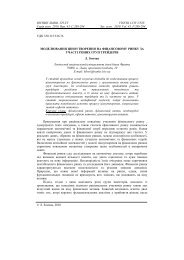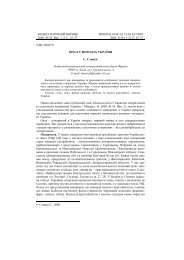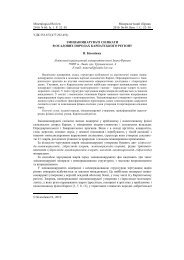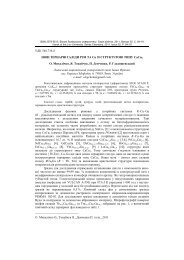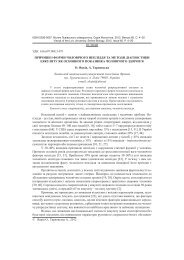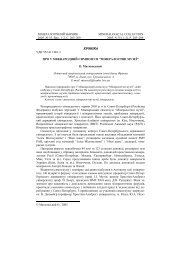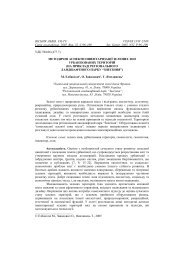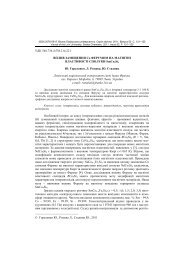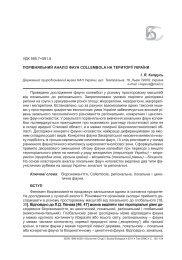Radosław Janicki - EVRICA
Radosław Janicki - EVRICA
Radosław Janicki - EVRICA
You also want an ePaper? Increase the reach of your titles
YUMPU automatically turns print PDFs into web optimized ePapers that Google loves.
USE OF GIS TECHNIQUES IN RESEARCH OF LANDSCAPE CHANGES ... 357<br />
also the authors of the first highly detailed maps of South Poland in small scale. Although<br />
there are older maps of Przemyskie Foothills, they are hardly useful for landscape research<br />
due to their large scale and unreliable content.<br />
In the years 1772 – 76, the survey of Galicia took place, which resulted in a map<br />
being made in 1:72 000 scale. This map was then reduced to the scale 1:288 000 and<br />
published in 1790 as „Koenigreich Galizien und Lodomerien”. In 1824 the same map was<br />
published again, after updating its contents. It was the oldest map used in this research.<br />
Although map was generally useful, results of its analysis are unfortunately imprecise<br />
because of the difficulties in defining areas due to inaccuracy and scale. The second map<br />
(Spezialkarte, K. u. K Militär-geographisches Instytut) that was used is from circa 1912 and<br />
also far from perfection. This Austrian map, however, has a more suitable scale for<br />
landscape research – 1:75 000. Inexactness of this map comes from the fact that borders of<br />
forested areas are hard to define. This monochromatic map shows relief in an old fashioned<br />
way. Instead of contour lines authors used shadowing, which makes it very hard to find<br />
borders of forests, since both things were shown in the same colour. The map that can be<br />
considered modern, is a coloured one from the years 1936-39 printed in 1:100 000 scale by<br />
the Polish Military Geographical Institute (WIG). After the World War II the Polish State<br />
Cartographic Publisher (PPWK) issued maps in scale 1:50 000 that depicted the<br />
environment in the years 1964–74. There are also maps in scale 1:25 000 from the early<br />
eighties but they have not been investigated for this research. The most recent map of the<br />
area is a digitally-based map in the scale 1:100 000 made for the order of Polish National<br />
Inspection of Environment (PIŚ). The maps covered the whole terrain of Przemyskie<br />
Foothills Landscape Park.<br />
To investigate the landscape changes more closely, two villages were selected –<br />
Łomna and Łętownia. Comparisons were made on the land uses in both villages between<br />
the years 1852 and 2002. Austrian occupants for military and taxation purposes prepared<br />
the cadastral maps from 1852. Franz Joseph I ordered them in 1817, triangulations and<br />
other measurements were undertaken in 1844–54 [7]. Maps are coloured and show all<br />
elements of land use in a very precise manner, due to map’s scale – 1:2 880. However the<br />
recent land use situation was presented in black and white aerial photographs in scale<br />
1:13 000, field verification was necessary to use these pictures due to their lack of colour.<br />
All cartographic materials were scanned with standard resolution 300 dpi (dots per<br />
inch) in full colour except for aerial photographs. As the materials were in black and white,<br />
they were scanned as one but with higher resolution – 600 dpi. The next step was<br />
rectification. This means giving the scanned maps cartographic coordinates.<br />
To rectify, the National System of Geographic Coordinates of 1965 was used,<br />
because most of available maps were representing it. All materials were rectified to<br />
represent the same type of projection and coordinates. This way, every rectified<br />
cartographic material can be compared with another since they represent the same<br />
projection and scale, regardless of the original features of the maps and aerial photographs.<br />
The last operation was to digitise all possible themes of maps. Digitisation was<br />
done with „screen method". Digitised themes can represent three types: point, linear and<br />
polygonal. Settlements were considered as point type, because of the scale of maps and also<br />
their marginal significance compared with the vast area covered by a landscape park. The<br />
same was done in the case of village comparison. Even though houses are polygonal units<br />
in small scale like 1:2 880, they were still digitised as points, because they were not too<br />
important in this research. Roads and small rivers were assigned linear themes. The most<br />
important aspect of this research were assigned to polygonal themes, such as: fields,<br />
meadows, pastures, orchards, forests and barrens as well as big rivers and old river-beds.



